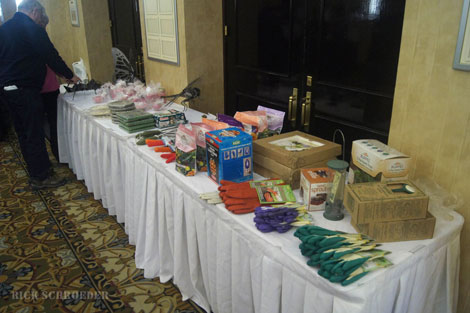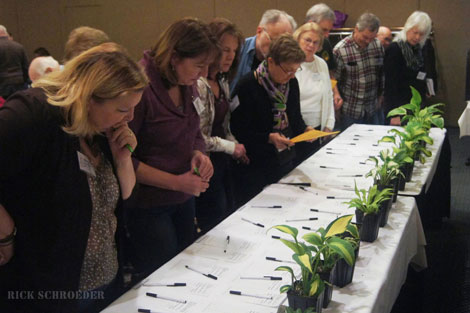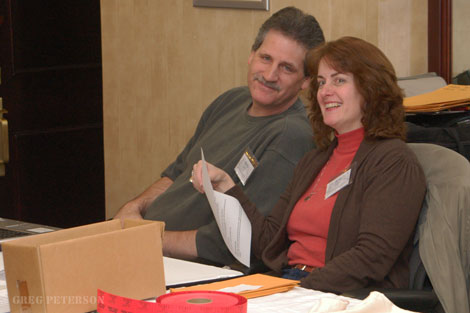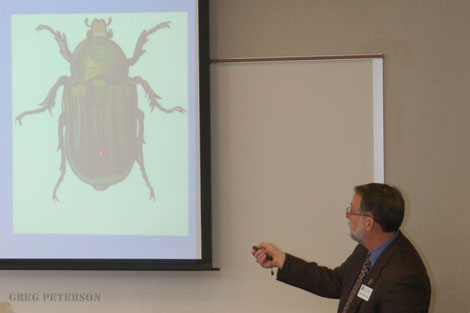|
Bob's presentation
was entitled “What Makes a
Great Hosta?” After
everyone jotted down
the names of their favorite hostas, the rating system to choose the
Benedict
Garden Performance Award was explained. How
would our own favorite hostas be judged according to this rating
system? Would any
of them make “Hosta of the Year?” I
know mine wouldn't, but they're still my
favorites! The rest
of his talk
concerned the fourteen traits of greatness, as pertain to hostas. These include: grows well, color,
variegation, size,
accessories (ruffled leaves, etc.), identifiable (distinctive),
hybridizer,
genetics, name recognition, series of sports, availability, marketing,
celebrity, and longevity. In
Bob's
opinion, 'Blue Mouse Ears' is the best name ever for a hosta with 'Sum
and
Substance' coming in a close second. He
also touched on one of my pet peeves as a hosta collector – finding a
description of a hosta (in The Hostapedia,
for example) that sounds like something I've got to have, only to learn
it’s
not available. Some
hostas that were
once popular are now considered somewhat mundane. As
Bob noted, there are so many hostas being
introduced every year that as the public was once fascinated by any new
hostas,
they are now seeing flaws in hostas that were once considered
“special.” What
makes a great hosta? The
WOW FACTOR!
Next,
Glenn Herold, President of the Midwest Regional Hosta Society, gave a
presentation on “The Korean Hostas and their Contributions to the Hosta
Garden.” Eight
species that are
indigenous to Korea and its nearby islands were discussed. At first glance, these
hostas all look similar
– plain green hostas. Most
of the
species, however, have been used in hybridizing. For
example, whether it is piecrust leaf edges
from Hosta capitata, interveinal
puckering from Hosta yingeri, or
flowers that don't open from Hosta
clausa, each species is in its own way unique. The Korean hostas have been
used to produce
such cultivars as 'Potomac Pride', 'Mango Salsa', ‘Gemstone', and
'Whiskey
Sour'.
Olga
Petryszyn offered a breakout session entitled “Experiences and
Experiments on
Moving a Mature Garden - You Don't Have to Say Goodbye to Your Old
Friends.” Her
tenacity in handling the seemingly
unrelenting problems with which she was confronted, made me think she
was a
gardening saint. Her
home was victim to
eminent domain, but she had at least a couple of years to start digging
before
she had to vacate the premises. Since
her old home was being demolished and not being sold to new owners, she
also
had carte blanche in moving her garden. She
took everything, even the groundcovers! From
using forklifts to rip out trees and
shrubs, a pickaxe to get through clay soil, and dealing with bobcats
“suckin'
gas and haulin' ass” through her yard, Olga finally made the move to
her new
home and proceeded to plant her garden. She
had numbered the plants from her old
garden and put bamboo stakes with coordinating numbers where they were
to be
placed in her new yard.
|
 |
| Door
Prizes |
| |
 |
| Silent
Auction Competition |
| |
 |
| Mark & June Luthea |
| |
 |
| Richard Hentschel |
|
Her new front
yard was a south-facing hill that was provided with shade from maple
trees. To prevent
the roots from these maples from
coming up and strangling the hostas that were to be planted, she used
landscape
fabric which was treated with copper hydroxide on the underside. Everything got planted, even
though the
equipment sometimes slid down the hill. The
trees started to look sickly, so wells
were put around the trees and drain tiles were scattered about the
hill. The trees,
however, eventually died for lack
of oxygen. Once
more the hostas had to
be dug up and put in a raised bed, so that the trees could be taken
down and
young trees planted. The
problem now was
that the area was too sunny. Cedar
posts
with shade cloth were installed over plants in the front yard. Moral of the story: hostas are survivors, and
so are their
gardeners!
I
sent my husband, Jim, to the breakout session hosted by Rob Mortko of
Made in
the Shade Gardens. “Tissue
Culture for
Dummies...Like Me” sounded like a good presentation for the hosta
lover. In
attendance were nursery personnel and
collectors, as well as hybridizers. Jim
has
a biology degree, with some background in lab work. He
has been interested in tissue culture, but
became discouraged as to his ability to be successful after doing some
research
on the internet. Fortunately,
Rob's
explanations filled in some gaps that the web research had left out. TC is labor intensive, but
when broken down in
steps, it is much easier to understand and accomplish. Essential, of course, is to
maintain a sterile
environment, which, for the average person, could be the most difficult
requirement. One
interesting fact was
that when taking tissue from a plant infected with nematodes, the
nematodes
will not be passed on to the new plants. That
is not true with HVX, however. (But
then, one shouldn't be working with HVX
infected plants!) Jim
noted that there
was a great Q & A session after the presentation, with the
answers being
concise and easy to understand. This
is
not always the case with questions on a technical subject. I have a feeling that our
basement will soon
resemble a lab.
As
I walked into the next seminar, I spotted the familiar face of Richard
Hentschel, who had been one of my Master Gardener instructors. Richard's topic was “Garden
Pests – The Good
Guys vs. the Bad Guys.” A
power point
presentation was used to explain the differences among insects and
their life
stages. Integrated
Pest Management (IPM)
was emphasized as a safe and responsible method for controlling “bad”
insects
and not harming the “good” ones.
Essential to this philosophy is correct
identification of the insect and
the stage the insect is in at the time damage is noticed, so that
proper
control methods may be used. The
goal is
not eradication of a particular insect in the garden, but to determine
whether
or not control is warranted at all – economic threshold level vs.
economic
injury level. IPM
includes cultural,
biological, mechanical, and, as a last resort, chemical control methods. Controls should be applied
when the insect is
in its most vulnerable life stage, using the safest product available.
In
the afternoon, Mark Zilis of Q & Z Nursery in Rochelle,
Illinois (and
author of the hosta bible – The Hostapedia)
presented “Hostas of Distinction – Part 12.”
Mark discussed not only a few of the unique
hostas he has seen in some
of the hosta gardens that he has visited throughout the years, but also
revealed some of the equally unique hybridizers. Some
hostas worth mentioning are: 'Dorothy
Benedict', a breakthrough in
hybridizing for its thick substance and variegation; 'Golden Tiara',
the first
small hosta with gold edges; 'Paul's Glory', the greatest gold-centered
hosta,
and the “groundhog hosta” found at Wade and Gatton, 'Sum and Substance'
which
is 9 ½' wide and 5' high. (Size
due to a
groundhog being buried beneath it???) Mark's
visits to Japan throughout the years have enabled him to explore the
native
growing areas of several Hosta species, as well as getting together
with some
of the Japanese hosta experts and sharing both knowledge and ideas. It was in Japan that he saw
his first species,
Hosta montana,
growing in volcanic soil. On
his fifth trip, in 2012, he came to the
realization that there is a lot more potential in hybridizing when the
species
plants are vastly different in the wild. Hosta
longpipes, for example,
varied
greatly within a quarter mile radius. Some
exhibited narrow curled leaves while others had dark green wide leaves.
Then,
there were those specimens that
resembled neither! In
October, Mark
received an email from Japan informing him that H.
sieboldiana had been discovered in the wild on a cliff in
Japan.
This
will add fuel to the ongoing debate
as to whether it is a species or a cultivar. Mark
also shared with the audience that he
believes 'Tosayama' should be a species, not a cultivar, and has made
it one of
his goals to make sure that this hosta becomes a species. Lastly, and to much
applause, Mark announced
that the second edition of The Hosta
Handbook will be released in the late spring. It will differ from the
first edition by
including info about tree and shrub compatibility, as well as a
problem-solving
guide. I'm sure
we'll all be looking
forward to it!
Last,
but not least, Jeff Miller of Land of the Giants Hosta Farm in Milton,
Wisconsin, presented “So You Want a Shade Garden – Building a Shade
Garden Dos
and Don'ts.' Jeff
reminded everyone to
put a 12-12-12 fertilizer and a slug repellent around where hostas grow
as soon
as the snow is gone. If
hostas have
started to emerge by the time you get around to doing this, it is still
okay to
put both fertilizer and repellent over the pips. Since
slugs tend to retreat in July and
August, when the weather heats up and the ground is drier, it is
essential to
use the slug repellent in spring and early summer.
Planting hostas in groups of three, of
course, makes clumps faster, but Jeff also suggested the “fifty foot
rule”
pertaining to the different colors of hostas.
The discussion turned to hosta enemies, such
as southern blight, foliar
nematodes, voles, slugs (again – they are persistent), and HVX, with
helpful
hints to handle each. In
conclusion,
Jeff's parting words were, “Don't be afraid of sun!”
A summary of the
WSM would be incomplete without the mention of the annual Seed
& Plant
Silent Auction that is held throughout
the day. A handout
was distributed with
around 90 choices for the attendees to bid on. Last
year, at my first WSM, I was able to win
three lots of blue hosta seeds. Since
blues are my favorite, I tried bidding on five different lots of blues
this
year. Unfortunately,
I had no success. Apparently,
I'm not the only blue lover! I'll
try again next year...
|

